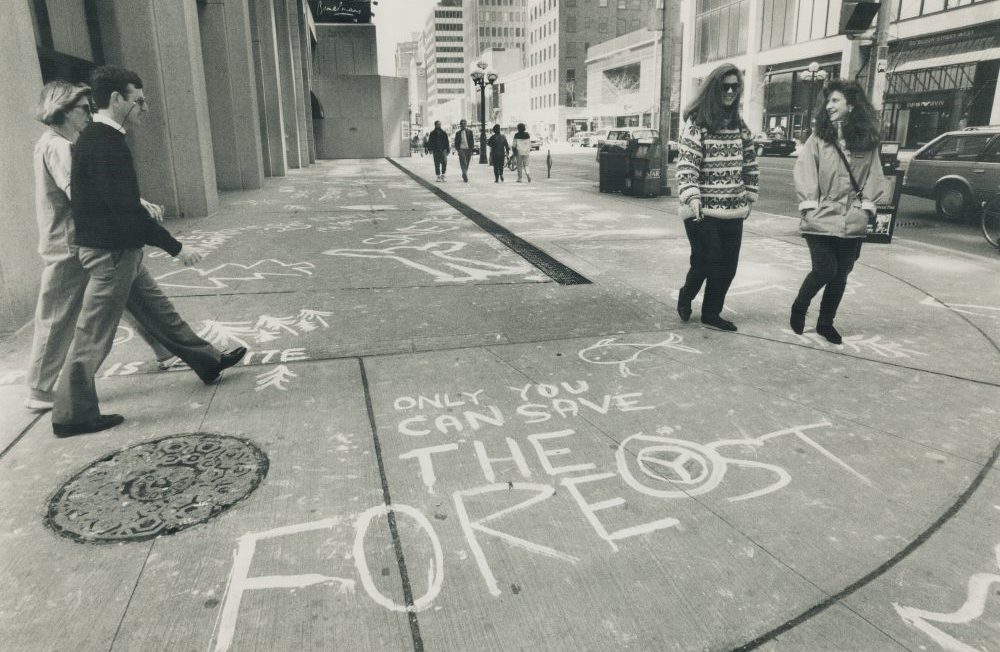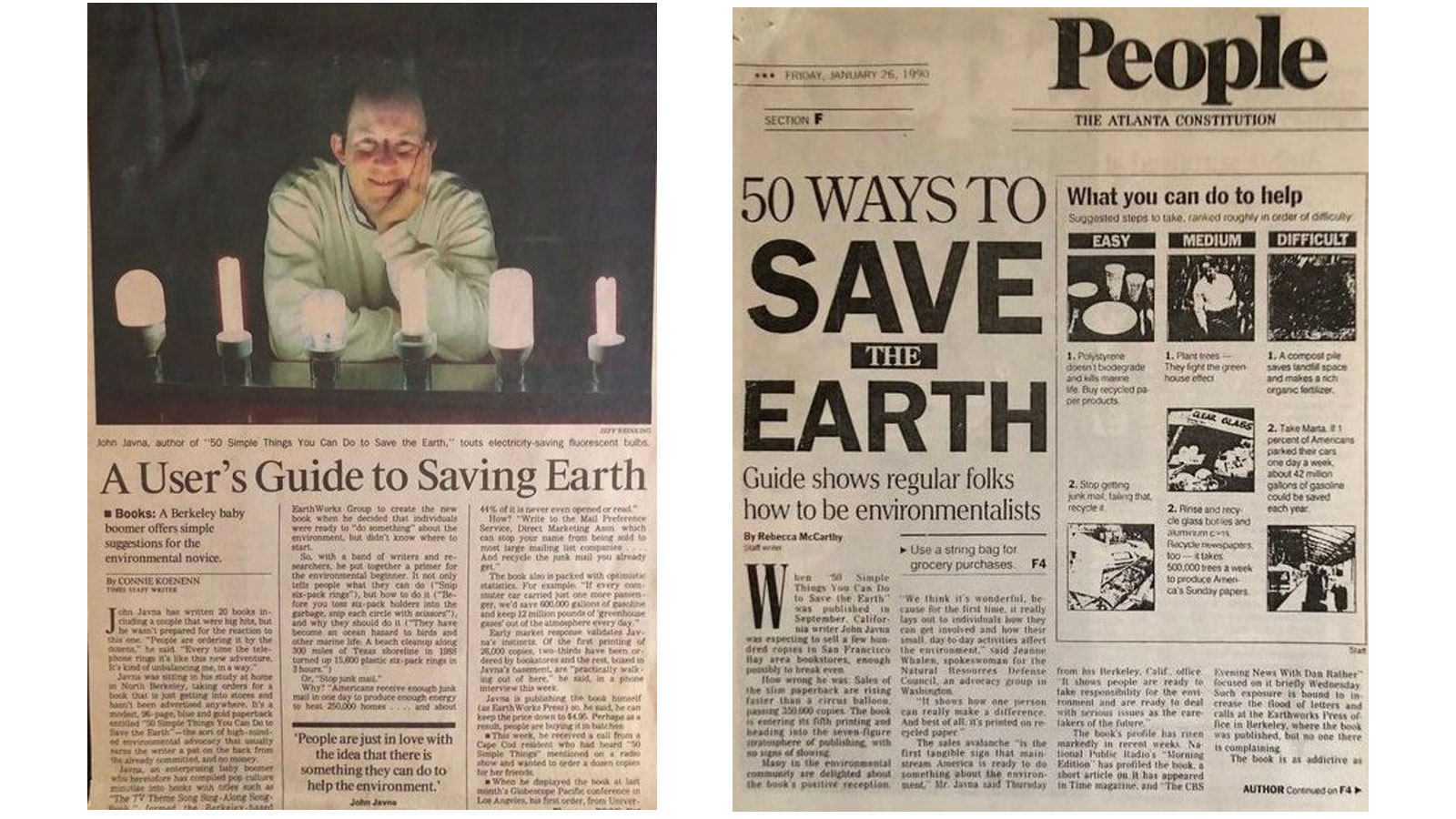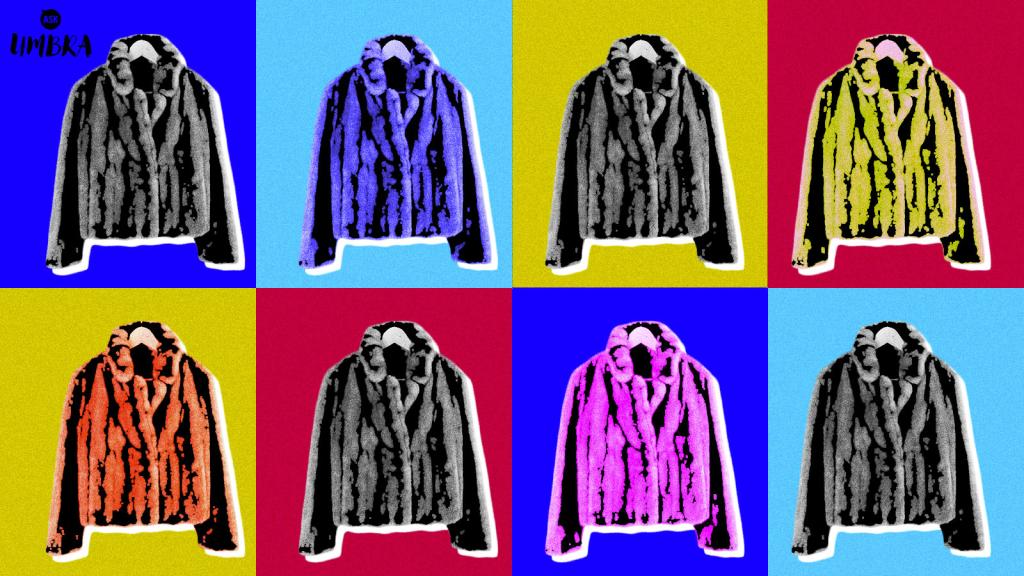It was the late 1980s, and the headlines warned of acid rain, air pollution, and contaminated water. So John Javna, then a writer best known for books found on the back of toilets, traveled from drought-stricken California to Washington, D.C., with his backpack, looking for practical advice on how to save the world.
About to turn 40, Javna had written the bestselling Uncle John’s Bathroom Reader series, full of trivia like the origin stories of Silly Putty and Gatorade. But this time he wanted to write something that would ease his fear that the world was falling apart. He showed up at the offices of the big environmental groups in D.C., collecting books and pamphlets full of eco-friendly tips (pre-internet, such things were harder to find) to cobble together a book full of green advice. Javna remembers being told by one environmental advocate that he was wasting his time.
His publishers weren’t fond of his idea, either. So in November 1989, without fanfare, Javna self-published the book he’d written in his attic in California: 50 Simple Things You Can Do to Save the Earth. The guide featured “unbelievably easy” steps, like installing low-flow showerheads and bringing cloth bags to the grocery store.
And then, seemingly out of nowhere, the book became a cultural phenomenon. With sales buoyed by media coverage and events surrounding Earth Day’s 20th anniversary in 1990, 50 Simple Things topped bestseller lists. It went on to sell 5 million copies and was translated into 23 languages, including Turkish and Bulgarian. The popularity spurred more than a dozen spinoffs in the 50 Simple Things series — including a kids’ version that Chelsea Clinton read growing up in the White House — that in the end sold just as many copies as the original.
“It was a pretty odd experience,” Javna said. “You’re sitting there doing the same thing you’ve always done, and suddenly the whole world starts looking at you, jumping up and down, and calling you on the phone.”
50 Simple Things had its share of critics, inspiring a genre of takedowns. They argued that meaningful change required complex and large-scale policy changes, not simple fixes. In 1991, Gar Smith wrote the article “50 Difficult Things You Can Do to Save the Earth,” featuring hardcore tips (“go to jail for something you believe in”) and calls for collective action (“pass a nature amendment to the U.S. Constitution”). Several years later, J. Robert Hunter wrote Simple Things Won’t Save the Earth, arguing that the growing popularity of eco-friendly products and habits gave people the false impression that environmental crises were being solved.
By the mid-90s, Javna had joined the critics. “I had this vision that it would be a gateway, an entry point, for people, and that they would get more and more involved,” he said. “After a few years, it was quite clear that they weren’t.” People were just snipping their plastic six-pack rings, feeling a little better about themselves, and calling it a day.
So Javna pulled his book from print and moved his family to rural Oregon, where he still lives today, two decades later. He even stopped taking his own eco-friendly tips.
“What did it matter if I recycled paper, if the ancient forests were still being chopped down?” Javna wrote in reflection in 2008. “Who cared if I celebrated ‘no car day’ when 80 percent of the cars on the road had one person in them? There was mercury in the air, and tons of waste was being dumped in the ocean daily. Every time I looked in the garbage and saw a pile of aluminum cans, I felt like giving up.”
While many climate activists today are demanding an entire overhaul of the economy and political system, they continue to wrestle with their personal contributions to the climate crisis: air travel, meat-eating, driving a car. At this year’s Golden Globe Awards — where the menu was completely vegan and glasses of water replaced plastic bottles — celebrities called on each other to step up. “It’s great to vote, but sometimes we have to take that responsibility on ourselves and make changes and sacrifices in our own lives,” said Joaquin Phoenix, who won Best Actor. “We don’t have to take private jets to Palm Springs for the awards.”
Individual responsibility for the environment has become what Javna calls “the wallpaper of culture” — taken for granted. Despite selling nearly as many copies as Rachel Carson’s Silent Spring, the book that launched a wave of awareness around the pesticide DDT in the 1960s, 50 Simple Things has been largely forgotten by the public. The book doesn’t even have a Wikipedia page. Yet it might have changed how millions of people think about their role in environmental destruction — and how they act in response.

Sidewalk art from Earth Day 1990. Ron Bull / Toronto Star via Getty Images
In 2006, Javna’s 13-year-old daughter, Sophie, asked him why their family didn’t compost anymore. “You should care about this stuff!” she remembers thinking. “You’re like the person who should care.”
Sophie was close to her dad growing up. They’d go on walks on the trail behind their house in Ashland, talking about life, and as she got more excited about recycling and farmers markets, she started getting on his case. Her conversations with her dad prompted him to revive the long-dead book and rewrite it in collaboration with his kids, with a new focus.
“It dawned on me that I couldn’t afford to be cynical — I had to keep trying to make the world better — because I love my son and daughter, and because I love this planet,” Javna wrote in the introduction to the revised 2008 edition of 50 Simple Things.
The new book was still broken into steps but encouraged readers to pick one cause — like bringing back the electric car or saving coral reefs — and get involved with environmental organizations, pressure companies to do better, and lobby their legislators for their cause. In other words, no more slacktivism.
The idea that individuals could help fix the planet’s overwhelming environmental problems was already part of the American psyche in 1970, the year of the very first Earth Day, when 20 million Americans joined in the events. Across the country, demonstrators demanded that politicians clean up the air and water, and the ensuing decade brought the establishment of the Environmental Protection Agency along with the Clean Water Act and Endangered Species Act, along with scores of environmental regulations.
“In 1970, everyone took for granted that tough laws were needed to protect and clean up the environment,” said Adam Rome, professor of environment and sustainability of the University at Buffalo.
The flurry of environmental action books that came out in the early 1970s included practical advice, like how to make your own soap, but they tended to conclude with a stirring call for citizens to demand large-scale change. The children’s book S.O.S. Save Our Earth, published in 1972, ends with a section telling kids to send postcards with examples of pollution to their city council, members of Congress, and the Interior Department, responsible for overseeing national parks and forests.
And then came the 1980s, a tough decade for the environmental movement. Ronald Reagan’s two-term presidency, in its zeal to unleash the free market, eroded faith in government action. “It was eight lost years — years of lost time that cannot be made up and where a lot of damage was done that may not be reparable,” George T. Frampton Jr, then-president of the Wilderness Society, told the New York Times in 1989, the same year that Javna self-published 50 Simple Things.
The era brought a shift in how Americans thought of themselves — not so much as citizens but as consumers who could vote with their spending power.
The strategy of boycotting Coca-Cola for its involvement in apartheid South Africa ended up working in 1986, when the company withdrew its operations from the country. Throughout the 1990s, Nike faced boycotts over low wages and poor working conditions in its factories. Environmentalists thought something similar could work for them. The focus shifted from collective action to consumer action: pushing businesses to be more sustainable and living a greener lifestyle.

A Dear Abby column from July 1990 called 50 Simple Things “required reading for everyone entering the 21st century.” John Javna
In his introduction to the original 50 Simple Things, Chris Calwell of the Natural Resources Defense Council, wrote that institutions alone couldn’t solve environmental problems, but the sum of millions of people taking action just might. “My trash, your use of inefficient cars, someone else’s water use — all make the planet less livable for the children of today and tomorrow. But remember: as much as we are the root of the problem, we are also the genesis of its solution. Go to it!”
That kind of thinking had it backwards, Rome said. “Only people who had been worn out from a decade of fighting would say that, because it’s obviously the opposite of what you need to say. Until institutions change, we aren’t going to solve any of these problems.”
After the Javnas finished rewriting 50 Simple Things in 2008, they turned their focus to the food system. Sophie now lives in Minneapolis and serves on the Equity, Inclusion, and Justice committee of the national branch of Slow Food, an organization working for a cleaner, fairer food system. And during the Great Recession, when Javna’s local food bank in Ashland announced it might have to close some days, he decided to do something about it.
“My neighbors would be perfectly willing to give something if it was made easy for them,” Javna remembers thinking. So he helped develop a system to go door-to-door to pick up food, which turned into the Ashland Food Project in 2009. It’s still going today. Donors fill a green bag with nonperishable food once every two months and put it outside their front door. The neighborhood coordinators pick up the bags and deliver them to local food banks. The idea is that each person does a small part — a “simple thing” — but understands that their part is just as essential as everyone else’s.
“We hope that this will become a different kind of paradigm in grassroots action,” Javna said. The project has brought millions of pounds of food to local food banks, with nearly a quarter of households in Ashland participating. The model has spread to dozens of communities, spawning independent Food Projects from the West Coast to Massachusetts, Kentucky, and Florida.
“50 Simple Things taught me that you can do something small in your attic, and it can have this unexpected impact on other people,” Javna said. With his work in Ashland, he’s spent the last decade figuring out how to design a system for social change that makes it easy and compelling for people to stay involved instead of losing steam. “You take somebody’s impulse to do something on their own and combine it with other people’s impulse to do it on their own, and engineer a system that makes it possible for each of them to play a part in creating a bigger impact,” he said.

John Javna
Two decades after 50 Simple Things came out, the environmental movement is gaining momentum again. Or rather, “Momentum” — a relatively new organizing strategy that’s influenced the Black Lives Matter movement as well as climate-focused groups like Extinction Rebellion and the Sunrise Movement. It offers a blueprint for sustaining social movements, instead of watching them peter out after a protest or two. As Rebecca Leber wrote for Mother Jones, the idea behind it is to come up with a narrative of what you want to accomplish, attract a wider base through protests, and then round up eager new members to join in-person trainings. Filling city streets with one well-attended march is just the beginning, rather than the end goal.
“In the end, if anything works, it’s not spreading yourself as thin as possible and doing the easiest possible things,” Javna said. The path to success, he believes, is joining a community of people trying to change something for the better — and if the system is set up effectively, then doing the right thing becomes simple.




